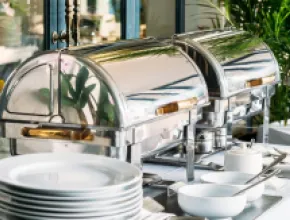Taking a welcome break from the catering storm that is the Governors Ball, Amy Unell, vice president of operations for Wolfgang Puck Catering, took a few moments to share how her experience managing one of the most high-profile catering operations in the world can translate to meeting planners.
1. Stay in Your Lane: Wolfgang Puck Catering’s Governors Ball operation had some 900 staff members serving a ball of roughly 1,200 participants. Everyone needs to conduct their job with ruthless efficiency.
“Stay in your lane and do what you do well,” Unell said. “Our company is set up in a fashion where salespeople sell and communicate with their clients, and then they’re introduced to an operations manager who is an operations manager. Salespeople are not in operations.
“So we have set up the company in a way that once a sale is firm and happening, an ops manager comes into the mix and is working with the client on all the logistics, from the room layout to the equipment ordering and the construction of realistic timelines,” she added. “Know what you’re good at.”
2. Have Contingency Plans: Anything can happen at any time. That’s Murphy’s Law 101. Such as the famous story of when the power suddenly went out at the Governors Ball years ago.
Plan ahead for emergencies and have backup plans in place.
“Contingency plans—flash, there’s a solution to everything,” Unell said. “That’s why you’re in catering. All best-laid plans go awry for a variety of reasons, whether it’s rain, or the power goes out, or 10 of your staff members call in sick. Always in your back pocket there’s a solution. We adopt that mentality. If you don’t have that in your fabric you don’t work here. You can’t freak out.
“There’s a solution for everything,” she added. “It’s thinking creatively.”
“If you are solution-oriented it’s going to help you be successful.”
3. Know Your Guest Demographics: Different groups have different profiles, and meeting planners need to communicate with the catering team to make sure their specific needs and preferences are met.
“Know when their last meal was—it’s important to know that,” Unell said. “Know the demographic of the age group and the profession of what people do. Like doctors compared to the party we just did for Harley-Davidson—they just eat differently, not only in quantity, but in taste profile.
“It’s not across the board but you do have to make some generalities to develop your menu.”
4. Set Up Clear Lines of Communication: When the party starts, things can get crazy.
Having a clear idea of who is communicating what will cut through the chaos.
“A lot of times planners will bring in their crew, with dozens of planners across three days,” Unell said. “If there’s a change we can have six people come tell us, and that’s just not efficient; that leaves room for the game of telephone, so if they tell you six times, that means it will be slightly different each time.
“So when changes or alterations to the timeline happen, I think it’s important that the planner decides who’s communicating with who instead of just 'let’s communicate with everyone!'" Unell added. "That happens a lot.”
5. Dietary Needs and Preferences Are Fluid: It’s essential to know how many vegan meals you’ll need, same goes with vegetarian meals, lactose-intolerant meals, etc.
The game often changes once it’s time for the food to be served, however, so plan to be flexible.
“There are some events [where] … say you have a seated dinner for 500; you’re going to get a laundry list of special requests from them,” Unell said. “That’s great, but that’s not all of it.
“Not everyone bothers to tell a planner or caterer their special request,” Unell added. “And if the meal looks good and it’s vegetarian, guess what, I’ll want it, and I’m not a vegetarian.”







